Abstract
A method is described for the preparation, from a subcellular particulate fraction of wax bean cotyledons, of a soluble enzyme system that is capable of converting β-alanine to ethylene. In the presence of ATP, CoA, thiamine pyrophosphate, MgSO4, and pyridoxal phosphate, ethylene production is maximum at a 0.5 mm concentration of β-alanine. The system exhibits a pH optimum at 7.0 but when the pH is raised above 8, evolution of the volatile again increases and continues to do so up to pH 12. The enzyme system is stimulated by either NADPH or NADH; the concentration of NADPH necessary to obtain maximum activity is twice that of NADH. The requirement for a reducing agent is in agreement with the proposal that malonate semialdehyde, formed by an aminotransferase reaction from β-alanine, is reduced to β-hydroxypropionate. Both malonate semialdehyde and β-hydroxypropionate are better stimulators of production of the volatile in the soluble system than is β-alanine, and β-hydroxypropionate is a better stimulator than malonate semialdehyde. This system is also able to incorporate tritium from tritiated water into ethylene; this supports the proposal that ethylene is formed by the decarboxylation of acrylate, the latter being formed from β-hydroxypropionate.
Experiments with both cold and labeled malonate suggest that this compound stimulates ethylene production by acting as an end product inhibitor that prevents the loss of malonate semialdehyde from the pathway. Malonate does not appear to serve as a precursor.
Addition of cytoplasmic enzymes to the `soluble system' (prepared from particulate enzymes) results in a considerable boost in ethylene production, but the specific activity (mμ1 / mg protein) is lowered from that of the particulate enzymes alone.
Full text
PDF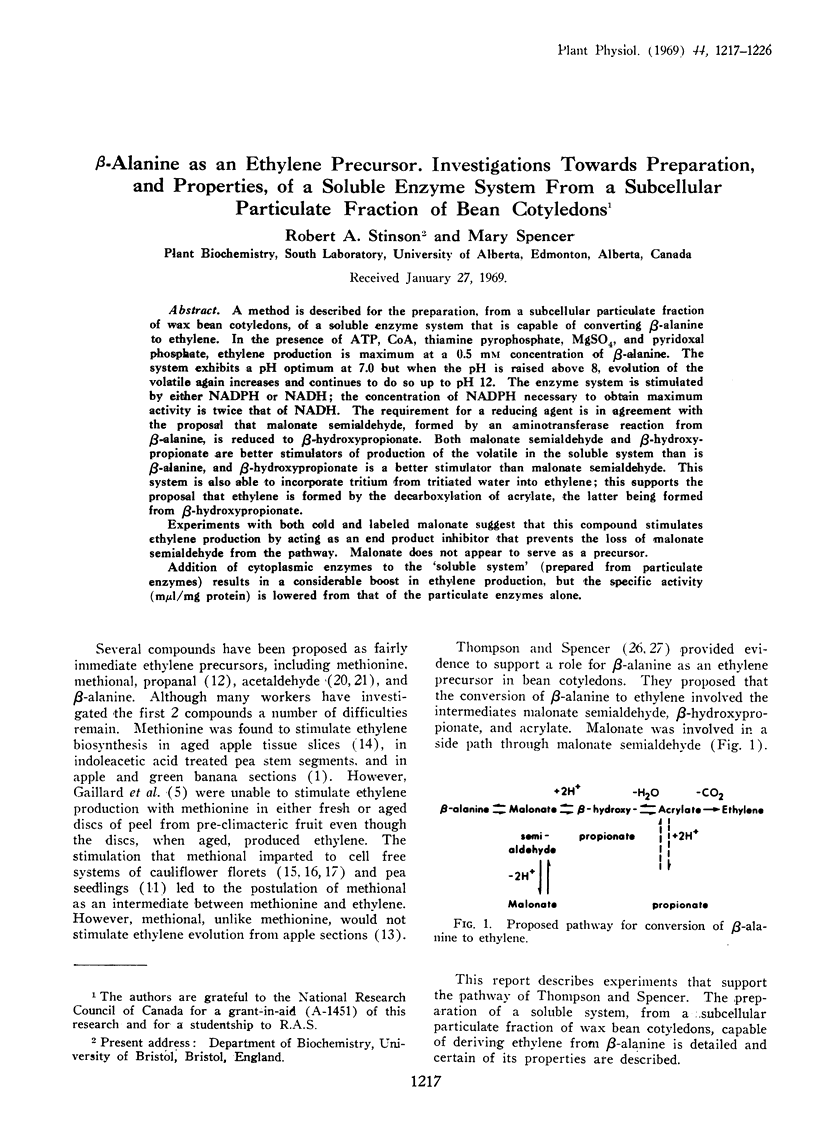
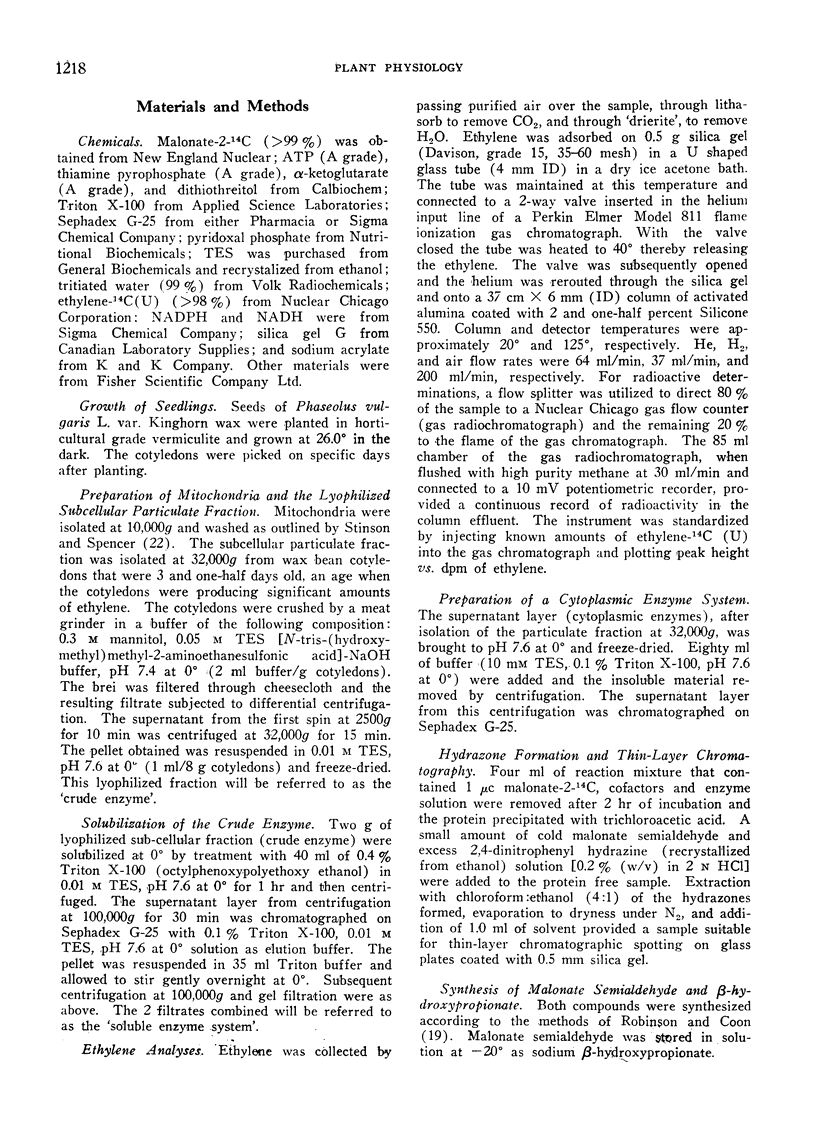

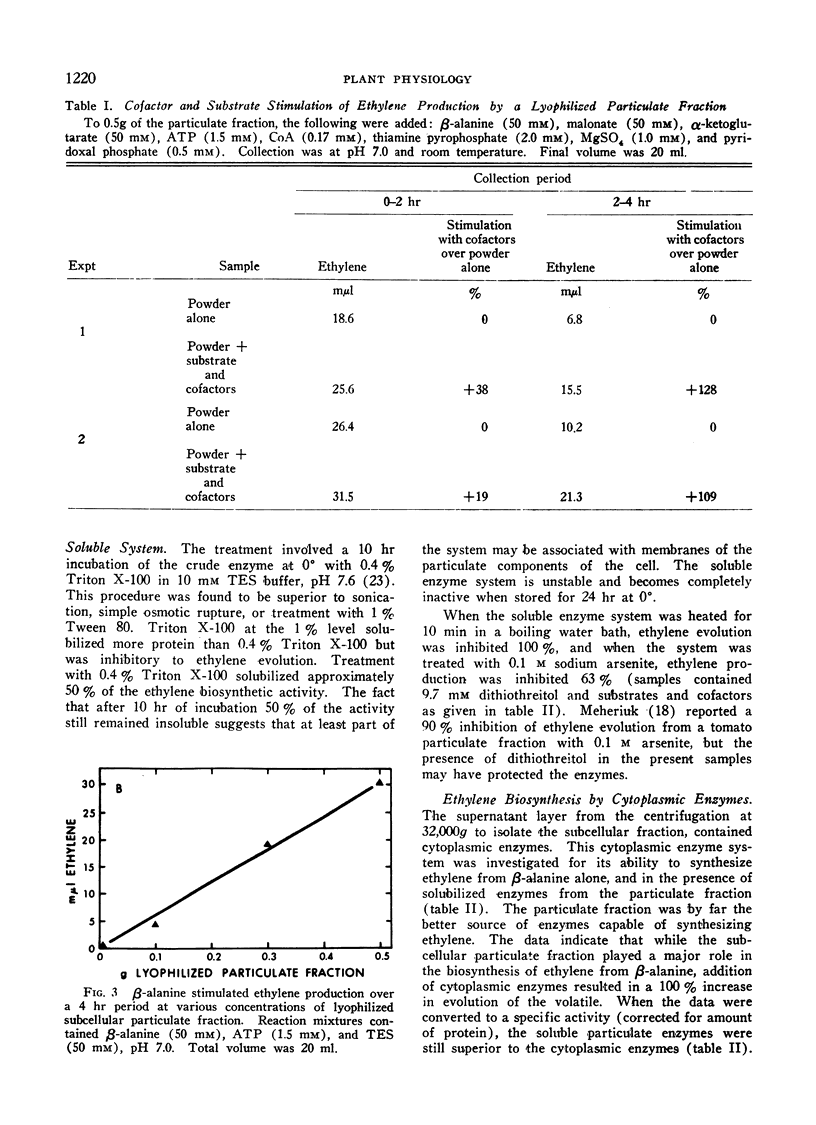
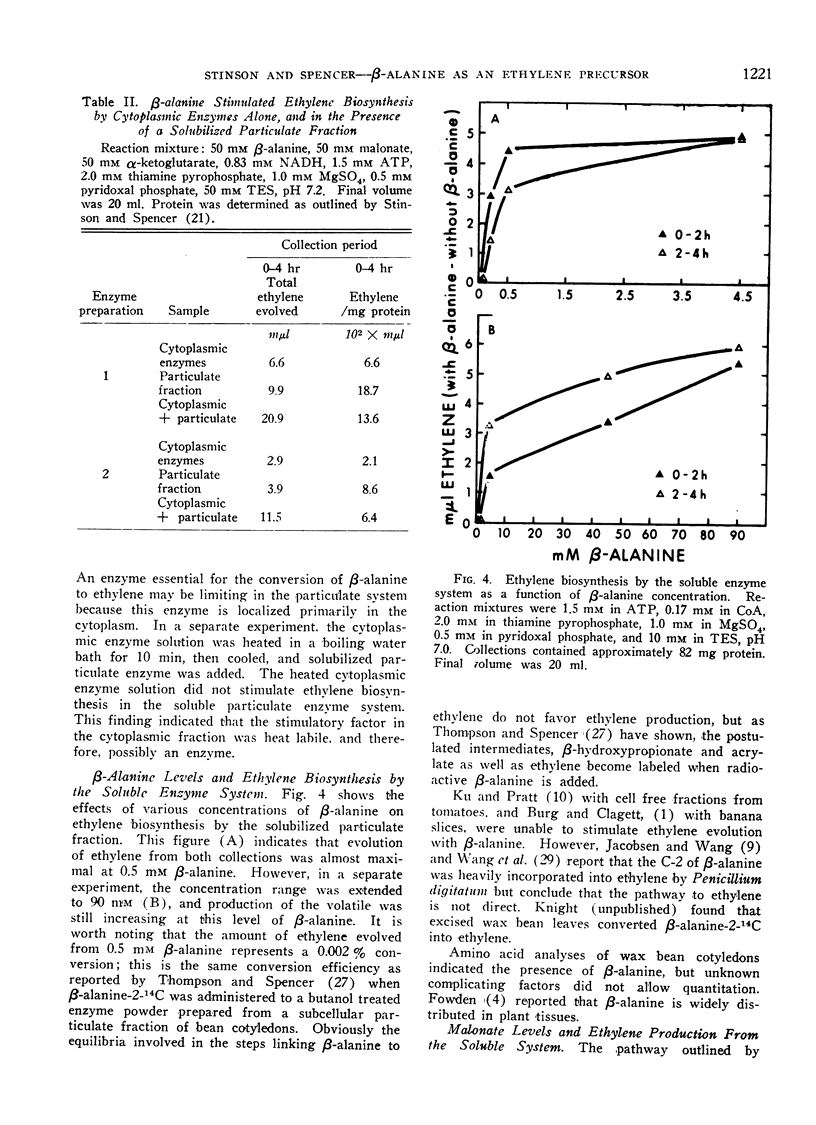

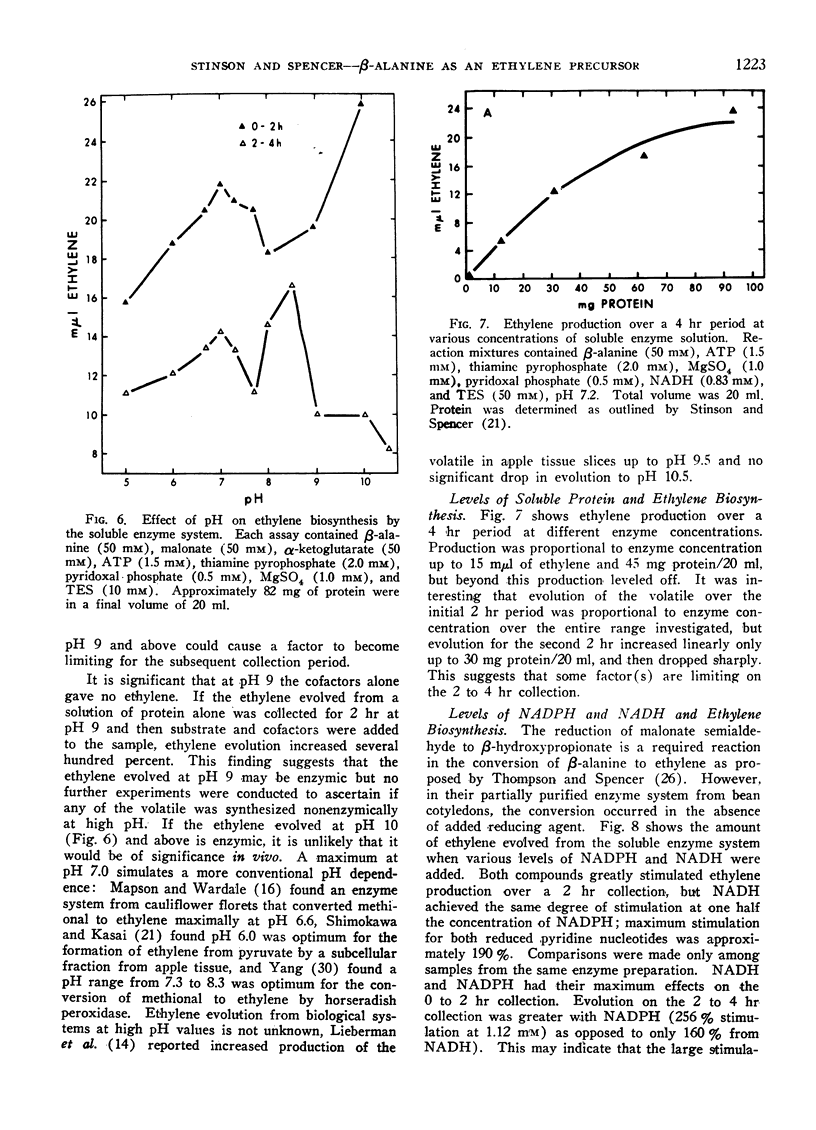

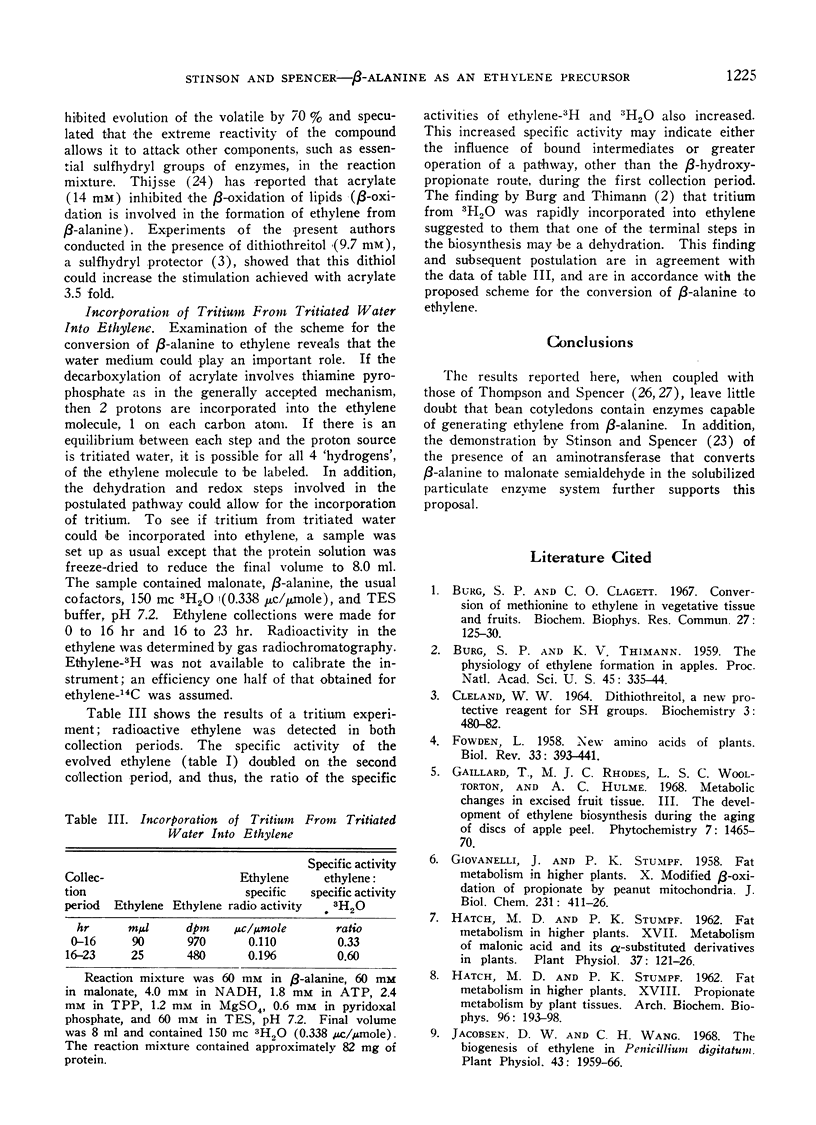

Selected References
These references are in PubMed. This may not be the complete list of references from this article.
- Burg S. P., Clagett C. O. Conversion of methionine to ethylene in vegetative tissue and fruits. Biochem Biophys Res Commun. 1967 Apr 20;27(2):125–130. doi: 10.1016/s0006-291x(67)80050-0. [DOI] [PubMed] [Google Scholar]
- Burg S. P., Thimann K. V. THE PHYSIOLOGY OF ETHYLENE FORMATION IN APPLES. Proc Natl Acad Sci U S A. 1959 Mar;45(3):335–344. doi: 10.1073/pnas.45.3.335. [DOI] [PMC free article] [PubMed] [Google Scholar]
- CLELAND W. W. DITHIOTHREITOL, A NEW PROTECTIVE REAGENT FOR SH GROUPS. Biochemistry. 1964 Apr;3:480–482. doi: 10.1021/bi00892a002. [DOI] [PubMed] [Google Scholar]
- GIOVANELLI J., STUMPF P. K. Fat metabolism in higher plants. X. Modified beta oxidation of propionate by peanut mitochondria. J Biol Chem. 1958 Mar;231(1):411–426. [PubMed] [Google Scholar]
- HATCH M. D., STUMPF P. K. Fat metabolism in higher plants. XVIII. Propionate metabolism by plant tissues. Arch Biochem Biophys. 1962 Feb;96:193–198. doi: 10.1016/0003-9861(62)90398-3. [DOI] [PubMed] [Google Scholar]
- Hatch M. D., Stumpf P. K. Fat Metabolism in Higher Plants. XVII. Metabolism of Malonic Acid & Its alpha-Substituted Derivatives in Plants. Plant Physiol. 1962 Mar;37(2):121–126. doi: 10.1104/pp.37.2.121. [DOI] [PMC free article] [PubMed] [Google Scholar]
- Jacobsen D. W., Wang C. H. The biogenesis of ethylene in penicillium digitatum. Plant Physiol. 1968 Dec;43(12):1959–1966. doi: 10.1104/pp.43.12.1959. [DOI] [PMC free article] [PubMed] [Google Scholar]
- Ku H. S., Pratt H. K. Active mitochondria do not produce ethylene. Plant Physiol. 1968 Jun;43(6):999–1001. doi: 10.1104/pp.43.6.999. [DOI] [PMC free article] [PubMed] [Google Scholar]
- Ku H. S., Yang S. F., Pratt H. K. Enzymic evolution of ethylene from methional by a pea seedling extract. Arch Biochem Biophys. 1967 Mar 20;118(3):756–758. doi: 10.1016/0003-9861(67)90413-4. [DOI] [PubMed] [Google Scholar]
- Lieberman M., Kunishi A. T. Ethylene production from methionine. Biochem J. 1965 Nov;97(2):449–459. doi: 10.1042/bj0970449. [DOI] [PMC free article] [PubMed] [Google Scholar]
- Lieberman M., Kunishi A. Stimulation of ethylene production in apple tissue slices by methionine. Plant Physiol. 1966 Mar;41(3):376–382. doi: 10.1104/pp.41.3.376. [DOI] [PMC free article] [PubMed] [Google Scholar]
- Mapson L. W., Mead A. Biosynthesis of ethylene. Dual nature of cofactor required for the enzymic production of ethylene from methional. Biochem J. 1968 Aug;108(5):875–881. doi: 10.1042/bj1080875. [DOI] [PMC free article] [PubMed] [Google Scholar]
- Mapson L. W., Wardale D. A. Biosynthesis of ethylene. Enzymes involved in its formation from methional. Biochem J. 1968 Apr;107(3):433–442. doi: 10.1042/bj1070433. [DOI] [PMC free article] [PubMed] [Google Scholar]
- Mapson L. W., Wardale D. A. Biosynthesis of ethylene. Formation of ethylene from methional by a cell-free enzyme system from cauliflower florets. Biochem J. 1967 Feb;102(2):574–585. doi: 10.1042/bj1020574. [DOI] [PMC free article] [PubMed] [Google Scholar]
- Stinson R. A., Spencer M. S. Beta alanine aminotransferase (s) from a plant source. Biochem Biophys Res Commun. 1969 Jan 6;34(1):120–127. doi: 10.1016/0006-291x(69)90537-3. [DOI] [PubMed] [Google Scholar]
- Stinson R. A., Spencer M. An evaluation of the effects of five buffers on respiratory parameters of isolated mitochondria. Can J Biochem. 1968 Jan;46(1):43–50. doi: 10.1139/o68-007. [DOI] [PubMed] [Google Scholar]
- THIJSSE G. J. FATTY-ACID ACCUMULATION BY ACRYLATE INHIBITION OF BETA-OXIDATION IN ALKANE-OXIDIZING PSEUDOMONAS. Biochim Biophys Acta. 1964 Apr 20;84:195–197. doi: 10.1016/0926-6542(64)90078-2. [DOI] [PubMed] [Google Scholar]
- Thompson J. E., Spencer M. Ethylene production from beta-alanine by an enzyme powder. Can J Biochem. 1967 Apr;45(4):563–571. doi: 10.1139/o67-065. [DOI] [PubMed] [Google Scholar]
- Tsai C. S., Axelrod B. Catabolism of Pyrimidines in Rape Seedlings. Plant Physiol. 1965 Jan;40(1):39–44. doi: 10.1104/pp.40.1.39. [DOI] [PMC free article] [PubMed] [Google Scholar]
- Yang S. F. Biosynthesis of ethylene. Ethylene formation from methional by horseradish peroxidase. Arch Biochem Biophys. 1967 Nov;122(2):481–487. doi: 10.1016/0003-9861(67)90222-6. [DOI] [PubMed] [Google Scholar]


